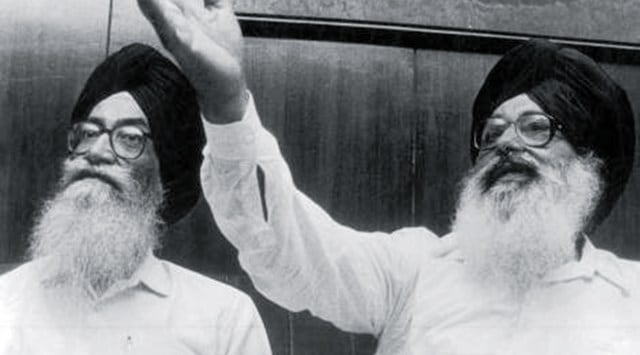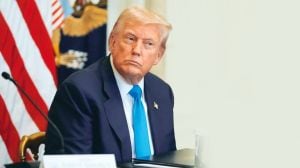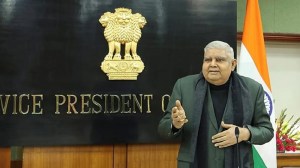A Look Back At History Of Shiromani Akali Dal: Party of jathedars and morchas formed to promote, protect panth, Sikhi
SAD's primary mission was promotion and protection of the rights of Sikh minority. It claimed to be the legitimate custodian of the Sikh community's political, religious and cultural interests.
 Parkash Singh Badal and Surjeet Singh Barnala. (Archive)
Parkash Singh Badal and Surjeet Singh Barnala. (Archive)Written by Harsukhinder S Badal
Twenty-nine days after the formation of 175-member Shiromani Gurdwara Parbandhak Committee on 14 December, 1920, the Sikh leadership got together to form the Shiromani Akali Dal under its first president Sardar Surmukh Singh Jhabaal.
Its primary mission was promotion and protection of the rights of Sikh minority. It claimed to be the legitimate custodian of the Sikh community’s political, religious and cultural interests.
SAD contested its first election as a political party in 1937 for provincial assemblies. It is argued that SAD has been the catalyst behind the major events in the politics of post-partition Punjab while being electorally the most successful party besides the Congress since the state was reorganised in 1966. One reason was its strong
organisational structure with peasantry as its core vote bank.
Justice Gurnam Singh became the first Akali chief minister of Punjab in March 1967. However, power led to divisions and groupism in the party with conservatives led by Sant Fateh Singh and Sant Chanan Singh facing off with the liberal CM. The ultimate beneficiary was Parkash Singh Badal who was sworn in the new chief minister at the helm of a coalition government of Akali Dal and Jana Sangh, which lasted for just over a year. But it was enough to place Parkash Singh Badal as first among equals in a field full of talented and ideologically driven leaders like Gurcharan
Singh Tohra, Harchand Singh Longowal, Surjit Singh Barnala and Jagdev Singh Talwandi.
SAD emerged as a movement-driven, cadre-based party whose ‘jathedars’ were mostly upright men, respected even by their rivals. Simple and rustic in their lifestyle, theirs was a life dedicated to the ‘panth’ and the party. It was not unheard of leaders, workers and their families giving up lucrative government jobs to court arrest when the party called for a mass movement. Arguably, the finest hour in the party’s history came when Prime Minister Indira Gandhi imposed Emergency. Leading opposition leaders were promptly arrested and newspapers came under censorship.
On June 30, 1975, the Akali Dal, at a special executive meeting held at Sri Harmandar Sahib, resolved to oppose the Emergency tooth and nail. From July 7, Akalis launched ‘Save Democracy Morcha’ from Akal Takht, offering daily voluntary arrests. Around 40,000 Akalis courted arrest during this period. As per the Amnesty International, 1,40,000 political prisoners were held without trial during this period. Though Sikhs comprised just 2 per cent of country’s population, 29 per cent of political prisoners detained were Sikhs.
In 1980, the nation forgave Indira Gandhi her sins of the Emergency and punished the Janata Party for its factionalism by returning former to power with a thumping majority. Sanjay Gandhi won handsomely from Rae Bareli. But the mother-son never forgot the dogged determination of the Akali Dal in Save Democracy Morcha and would try their best to marginalise the party in Punjab with disastrous consequences.
The seeds of militancy were sown on April 13, 1978 with the clash between followers of Sant Jarnail Singh Bhindranwale and the Nirankari sect. Thirteen Sikhs and three Nirankari followers were killed in the clash. It did not help matters when the case was transferred outside Punjab to Haryana and the judge let off all accused, calling it a case of legitimate self-defence. Bhindranwale was respected in the community as he headed the Damdami Taksal, a century-old seminary, which was founded by the legendary martyr, Baba Deep Singh. Matters took a turn for the worse when the Indira Gandhi government announced that river waters flowing through Punjab would be diverted to neighbouring states.
Akali Dal launched the Dharam Yudh Morcha in August 1982, which was subsequently supported and ultimately taken over by Bhindranwale. Akali politics had become truly radicalised. The situation was ripe for a showdown, a head-on collision between an authoritarian PM and the rebellious Sikh challenger embodied by Bhindranwale and his followers.
It came in the shape of ‘Operation Blue Star’, an army operation.
The desecration of Golden Temple and Akal Takht seared the collective memory of the Sikhs and left the community feeling isolated and bitter. It was the starting of a decade-long Insurgency, which claimed thousands of lives. The militancy enjoyed substantial mass support during the initial phase. Indira Gandhi’s successor, Rajiv Gandhi made a determined bid to solve the tangled situation. On July 24, 1985, Rajiv Gandhi signed the Rajiv-Longowal accord which made many concessions for Punjab, including handing over of Chandigarh as capital to the state. It gave rise to a mood of optimism in the Akali Dal cadre. However, for his bold move of trying to usher in an era of peace and reconciliation, Harchand Singh Longowal paid with his life. He was shot and killed on August 20, 1985 near a gurdwara in Sherpur village.
In the subsequent elections, Akali Dal won a landslide victory. Surjit Singh Barnala, a close confidant of Longowal, was sworn in the new chief minister of Punjab on September 29, 1985. Barnala was backed by PM Rajiv and had a capable deputy in finance minister Balwant Singh. But factionalism threatened to derail the Akali government as Parkash Singh Badal, who was not used to being edged out, waited in the wings for an opportunity. As the militants and the democratically elected government vied with each other in the battle of perception, Rajiv Gandhi, advised by his coterie, made a blunder. He had publicly backed the CM but was privately fearful of how a section of voters would react to the new tactic of militants of hitting soft targets, such as innocent bus passengers of a particular community.
As Haryana got ready for Assembly elections, Rajiv Gandhi sacrificed the Akali government headed by Barnala after just 21 months in power. For the Akali rank and file, it was another broken promise. As the violence became repressive and indiscriminate, and militants started targeting common people, the Sikh masses turned their back to the separatist movement. The slaughter and loot were against the Sikh ethos of ‘Sarbat Da Bhala’. As more intelligence flowed in from locals fed up with the senseless violence, then Congress chief minister, Beant Singh, and
DGP KPS Gill moved in for the final strike against militancy. With practically no support from the local population, the leadership of this insurrection was picked up one by one till it ran out of steam. For the first time in contemporary history, a separatist movement was crushed with no remnants. By 1995, peace descended on the state, and peals of of laughter once again returned to Punjab.
(The author has remained an office-bearer of Shiromani Akali Dal (Badal) from 1999 to 2017. He is now in Aam Aadmi Party)












